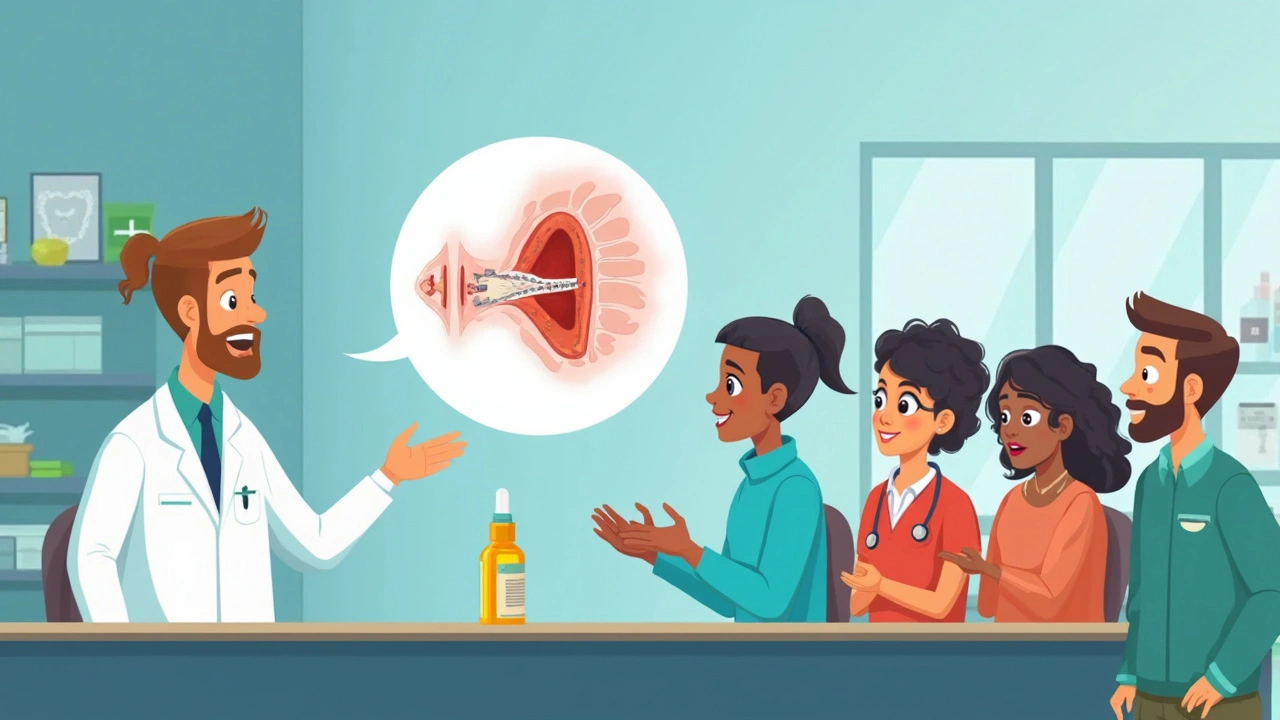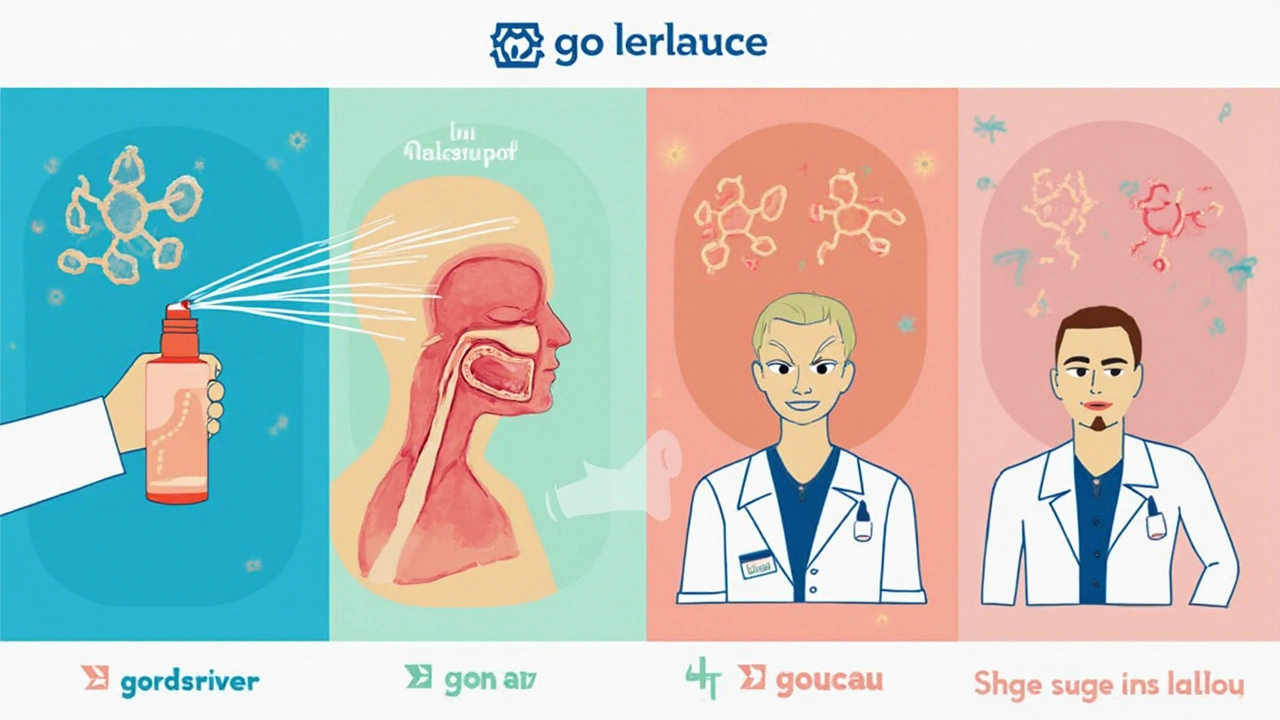
Grab an allergy spray and you might not think twice—until your throat starts aching. Maybe it happens once, maybe you just can’t shake a nagging soreness. The internet is packed full of stories connecting azelastine, a popular nasal spray, to tonsillitis or sore throats. Is there actually any real connection, or is this just allergy season confusion? Let’s cut through the rumors, the “Dr. Google” advice, and get clear on what’s actually happening in your nose, throat—and your tonsils.
Understanding Azelastine: More Than Just Allergy Relief
So what exactly is azelastine? It’s an antihistamine you squirt up your nose, usually to fight back against allergies that leave you stuffy, sneezy, or feeling like you need to pressure-wash your sinuses. Drug stores and pharmacy aisles are full of these sprays—Astepro, Astelin, and some generics. Azelastine works by blocking histamine receptors, basically lowering the body’s over-the-top response to pollen, pet dander, mold, or dust mites. But here’s where it gets interesting: unlike allergy pills like loratadine or cetirizine, azelastine delivers the medication directly where you need it most—right inside the nasal passages.
This localized action means you usually get fast relief with fewer whole-body side effects like drowsiness. People like it because it works within minutes and you can use it even if pills make you sleepy. Nasal steroids (like fluticasone or mometasone) can take a few days to kick in, but azelastine offers instant satisfaction. That said, it’s not all roses. Azelastine has a reputation for a pretty awful taste if it drips into the throat, and some users notice nosebleeds, headaches, or dry mouth. Still, it’s considered safe for daily use for most people, even kids six and up.
One thing people don't always know? Azelastine can cause mild throat irritation, especially with sloppy spraying technique. If you're blasting the spray straight back or holding your head too far back, some of that medicine might slide down into your throat, making it feel scratchy or sore. Here's a quick pro tip: keep your head upright, aim slightly out toward your ear—not back toward your throat. That keeps most of the spray right where it needs to be.
Current studies, like one published in the 2023 Journal of Allergy and Clinical Immunology, show that azelastine rarely causes serious side effects. But they confirm: up to 5% of users report mild sore throat. That’s not nothing—especially if you’re already prone to throat troubles during allergy season.
Bottom line: azelastine is effective and safe for most, but if your throat starts hurting after each dose, it’s probably not just your imagination. Next, let’s talk about when a sore throat crosses the line into something more: tonsillitis.
What Is Tonsillitis? Fast Facts and Common Misconceptions
If you grew up getting sore throats every winter, you’re probably familiar with swollen, red tonsils—the fleshy, golf-ball-like pads in the back of your throat. Tonsillitis means your tonsils are inflamed, usually from a viral or bacterial infection. It’s not just about pain; you might get a fever, trouble swallowing, and super swollen glands under your jaw. In the U.S., around 15 million doctor visits each year are for sore throat, with kids hit hardest.
The most common culprit is viral. Think common cold, adenovirus, or even the infamous “kissing disease,” mononucleosis. Sometimes, though, it’s bacteria—mainly group A strep, leading to strep throat. Tonsillitis is super contagious, which is why every parent dreads the classroom outbreak. But here’s the important part: allergies themselves rarely trigger tonsillitis. Your immune system might kick up some post-nasal drip, which can inflame your throat, but it doesn’t outright infect your tonsils.
There’s also a ton of confusion online. Google “tonsillitis and allergies” and you’ll find message boards packed with assumptions: “My allergy spray gave me tonsillitis!” It’s rarely that simple. Unless the spray damages the lining of your throat so badly it lets bacteria invade, you’re not likely to get full-blown tonsillitis just from an antihistamine. Still, those sore throats matter.
Curious what actually separates allergy-induced sore throat from real tonsillitis? Here’s a quick list:
- Allergy-related sore throats: Usually mild, scratchy, and come with post-nasal drip. No fever, no pus on tonsils.
- Tonsillitis: More intense pain, often with white spots or pus on the tonsils, plus fever, swollen glands, and trouble eating/swallowing.
Doctors almost always check for fever and look at your tonsils to tell the difference. If you’re running a temperature—over 100.4°F (38°C), it’s more likely to be infection, not just allergies or irritation.
Here’s a table with quick differences:
| Symptom | Allergy (Azelastine) | Tonsillitis |
|---|---|---|
| Sore throat | Usually mild, scratchy | Severe, persistent |
| Fever | Rare | Common |
| Swollen tonsils | No | Yes |
| Pus/white spots | No | Yes, often |
| Other symptoms | Runny nose, sneezing | Headache, stomachache, fatigue |
So, the big reveal: you’re not likely to develop true tonsillitis from using azelastine, but there’s more to the story. Let’s dig in below.

Is Azelastine Linked to Tonsillitis? Parsing Fact from Fiction
Here’s where things get heated on the forums. Some people swear their first sore throat or bout of tonsillitis started right after picking up a nasal spray. Before you toss your meds, here’s what the real-world science says.
First up, azelastine’s side effects: Throat irritation and mild soreness are known, and they happen to about 1 in 20 people. In some cases—usually when sprays aren’t used quite right—it leads to a raw or scratchy throat. That’s annoying, but not the same as tonsillitis. Bacterial or viral tonsillitis needs an actual infection, not just irritation. No mainstream, peer-reviewed study has confirmed azelastine as a trigger for tonsillitis itself. It can cause dryness, irritation, or make you cough—especially if you’re already prone to post-nasal drip—but actual tonsillitis is a different beast.
Certain folks might be a little more sensitive: children, older adults with less robust mucosal lining, and people with underlying immune or throat conditions. There are rare case reports—less than a dozen in the last ten years—where patients taking long-term allergy sprays developed recurrent throat infections. In these cases, it’s usually linked to improper spraying, high doses, or a weakened immune system rather than the drug itself. Most allergists and ENT (ear, nose, and throat) docs will tell you: the risk from azelastine causing real tonsillitis is very slim.
The way to avoid trouble? Perfect your spraying tech. Almost all reports of “throat reactions” come from people who aim the nozzle directly back, sending excess medication right down into the throat. Some experts suggest alternating nostrils, spraying gently, and waiting a few minutes after a dose before lying down or talking much. It’s also smart to rinse your mouth or gargle with water if you get that bitter taste, reducing irritation risk.
If you do start getting repeated, full-blown tonsillitis, it’s time to talk to your doctor. There could be an underlying infection, not related to your allergy meds. Bloodwork and throat cultures can help sort it out, and your doctor might recommend switching to a different med if you’re especially sensitive to azelastine.
Safe Use of Azelastine: Pro Tips to Protect Your Throat
Worried about using azelastine safely, or just tired of that nagging scratch after each spray? Tons of people deal with this, especially at the start of allergy season or when pollen counts are sky-high. Here are the best strategies—tested by long-time users and recommended by allergy specialists—to keep your throat comfy and side-effect free:
- Practice good spraying technique: Hold the bottle upright, keep your head level, and point the nozzle slightly outward (toward the ear on that side). That stops spray from streaming down your throat.
- Don’t overdo it: Stick to the prescribed number of sprays. Trying to “blast out” congestion won’t work faster—but it will increase side effects.
- Rinse after use: If you notice bitter taste or throat irritation, take a sip of water, gargle, or simply spit. This can cut down irritation fast.
- Stay hydrated: Dry mucous membranes get sore more easily. Keep a water bottle nearby, especially during allergy season.
- Watch for infection signs: If you develop fever, chills, or start seeing white spots on your tonsils, it’s time for a checkup. Don’t blame the allergy spray without a doctor’s weigh-in.
- Switch up your meds: If you’re sensitive, talk to your doctor about nasal steroids (which can also cause dryness, but may be tolerated better) or oral antihistamines.
- Humidify your air: Dry homes (especially during winter or heavy AC seasons) dry out your throat more. A small humidifier in your bedroom can make a big difference.
- Take breaks if needed: If your throat is feeling abused, take a day off from the spray (if your allergy symptoms let you) and let your throat recover.
One cool fact: Japanese researchers in 2022 found that using a nasal saline rinse BEFORE your azelastine spray cuts down on throat irritation, likely by moistening the nasal lining and washing away pollen. If you make this a habit, it might just keep you more comfortable all year long.
Doctors also say it’s smart to avoid using azelastine just before bed. Some people wake up with a super dry throat if the meds settle while they sleep. Spread your doses out and see if that makes a difference.

When to Worry: Red Flags and When to Call Your Doctor
Here’s the thing—while azelastine is rarely the villain behind full-blown tonsillitis, ignoring certain symptoms can land you in trouble. Don’t chalk everything up to “just allergies.” If you start noticing any of the following, it’s time to pick up the phone:
- High-grade fever (above 101°F/38.5°C), especially lasting more than a day
- Difficulty swallowing, or pain so bad you can’t eat
- White or yellow spots, pus, or foul odor from your mouth
- Swollen glands under your jaw or in your neck that are hard, tender, or growing
- Hoarse voice, muffled speech, or trouble breathing (rare, but urgent)
Any of these could mean a legit infection. Sometimes, especially in younger kids, tonsillitis can turn serious fast—even leading to abscesses that need quick treatment. Most urgent care centers can swab your throat (the dreaded “strep test”) and start treatment in minutes.
If your only symptom is mild scratchiness or that classic “drip” feeling after using azelastine, it’s usually nothing to panic about. Adjust your technique, drink more fluids, or ask your doc about alternatives. Ear, nose, and throat specialists see these problems every single day and rarely take patients off sprays completely—there are usually easy fixes.
One last word to the wise: Don’t share your nasal sprays, ever. Cross-contamination can turn a regular bottle into a germ fest, raising your risk for bacterial infection. Label your bottle, clean the nozzle with a quick alcohol wipe every few days, and store it somewhere clean and dry.
If you’re using other medications—nasal steroids, asthma inhalers, oral steroids—keep your doctor in the loop. Sometimes using multiple meds at once can make dryness, sore throat, or mild immune suppression worse. Communication is key.
Still worried? Allergy experts often remind folks: allergies can be miserable, but the medicines you use to control them usually aren’t the real enemy. The secret is in how you use them, and how quickly you spot the signs that something more serious is brewing.





Comments (11)
Aayush Shastri
Thanks for sharing this detailed breakdown on azelastine and tonsillitis. I’ve often wondered if that nasal spray could have a downside, especially since many people use it routinely during allergy season.
From what I've read before and now with your article, it seems the main concern is whether azelastine could potentially irritate the throat or cause symptoms resembling tonsillitis. It’s great to see the science laid out clearly here because misinformation tends to spread fast.
Do you think that patients using azelastine should monitor any throat symptoms closely, or is the risk low enough that it’s mostly safe to continue for people with allergies?
mathokozo mbuzi
This is indeed an interesting topic. I find that many allergy sufferers might confuse side effects with unrelated infections, leading to unwanted panic and possibly stopping treatments prematurely.
The article’s emphasis on understanding tonsillitis causes apart from medication is crucial. Tonsillitis tends to be viral or bacterial, so linking it to a nasal antihistamine spray might be a stretch in many cases.
Still, I appreciate the balanced approach here—highlighting expert insights and encouraging safe use. Has anyone here experienced any throat irritation from azelastine?
Amy Aims
Oh wow, I totally didn’t realize there could even be concerns about tonsillitis from using azelastine! 😊 Thanks for laying it all out so clearly.
Allergy seasons are tough, but it’s comforting to know that this spray is mostly safe if used correctly. I’ve personally used it off and on for years without any throat problems.
Still, it’s good advice to watch for symptoms and maybe consult an expert if you start feeling a sore throat that doesn’t seem allergy-related. Taking care is key! 🌸
Shaik Basha
Heyyy this real interesting, coz i use azelastine too when pollen attacks lol. i neva thought if it could make sore throat worse tho, but after reading this, its kinda clear now how it works.
Like it says, tonsillitis is usually bacterial or viral, not just some side effect.
btw i noticed sometimes after use my throat feels funny but maybe dats coz of allergies or dry air, not the spray itself.
Anyway, nice article, gonna keep using but will keep an eye on symptoms.
Sen Đá
While I appreciate the effort to clarify this topic, I must insist on the importance of differentiating adverse events caused by azelastine from coincidental infections. Anecdotal assumptions are rampant, yet empirical evidence remains pivotal.
This article commendably dismantles the misconception that azelastine sprays are a direct causative factor for tonsillitis. However, scrutiny of clinical trials and post-marketing surveillance data is warranted before drawing any definitive conclusions.
I would have appreciated more quantitative data and references to support these claims for better scientific rigor.
Penny X
Honestly, I'm a bit skeptical about this whole explanation. Tonsillitis isn’t something trivial and to suggest that a spray could be misleadingly blamed? Sounds like an excuse in some cases to me.
People put unknown substances in their bodies and ignore warning signs. The drama of enduring sore throats should not be taken lightly, and neither should side effects be dismissed so quickly.
There’s a need for more caution and accountability when it comes to recommending such sprays without thorough investigation.
Olivia Crowe
I love this thorough explanation! It’s so easy to get scared by rumors linking meds to worse symptoms.
Reading about how azelastine specifically targets histamine receptors and doesn't cause infections really clears the air.
For anyone worried: staying informed and consulting your healthcare provider if you feel something is off is the best plan. Don’t let anxiety overshadow your allergy management.
LEE DM
It's refreshing to see this topic handled so thoughtfully. In my experience, allergies and infections can sometimes masquerade as one another, which complicates treatment.
Education like this helps people make informed choices without fear-mongering. Hopefully, it fosters better dialogue between patients and doctors.
How about those with chronic tonsillitis? Could azelastine usage potentially exacerbate their condition? That'd be a useful angle to explore further.
Michael Ieradi
This post was informative. However, can we talk about how often patients self-diagnose and self-medicate? Often, they attribute symptoms from infections like tonsillitis to their allergy medication, complicating the picture.
Medical guidance is essential here. Besides azelastine’s pharmacological profile, patient history plays a key role in determining causality.
Encouraging consultation rather than assumption helps prevent unnecessary discontinuation or misuse of medications.
Stephanie Zuidervliet
Ugh, I just can’t stand how medication side effects cause so much confusion! Like, either use it properly or stop whining about mild throat irritation. Tonsillitis is serious and should be treated seriously.
Maybe the article should have been more upfront about potential dangers or what to look out for instead of brushing it off.
People deserve the full story, not just the sugarcoated facts.
Hannah Gorman
While many comments here are insightful, I must stress the necessity for individuals to not only rely on broad generalizations but to scrutinize the subtle pharmacodynamic interactions that azelastine may have with mucosal tissues.
Although the article aims to dispel myths, it overlooks the possibility of rare hypersensitivity reactions or local immunologic responses that could mimic or exacerbate tonsillar inflammation.
A nuanced understanding and long-term studies are imperative before dismissing all links as coincidental.